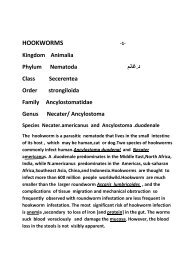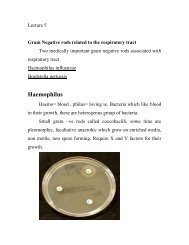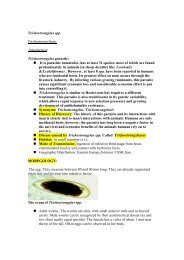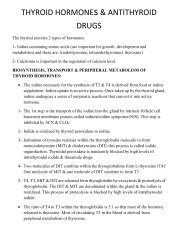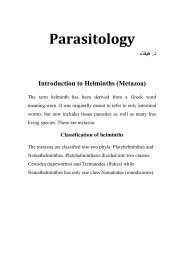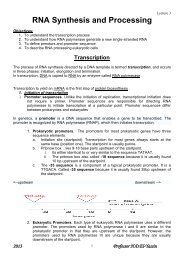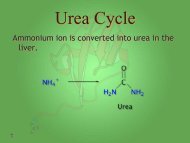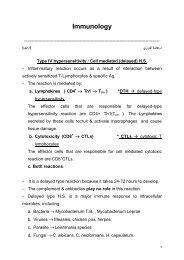RESPIRATORY SYSTEM Dr.Firdous RESPIRATORY EPITHELIUM
RESPIRATORY SYSTEM Dr.Firdous RESPIRATORY EPITHELIUM
RESPIRATORY SYSTEM Dr.Firdous RESPIRATORY EPITHELIUM
Create successful ePaper yourself
Turn your PDF publications into a flip-book with our unique Google optimized e-Paper software.
<strong>RESPIRATORY</strong> <strong>SYSTEM</strong><strong>Dr</strong>.<strong>Firdous</strong>It consists of two regions:1-Conducting portion: The main conducting airways in the upper part of the respiratorytract have walls that are reinforced with bone or cartilage to keep them open, and theirmucosal lining is adapted for cleaning and conditioning air on its way to the lungs. Theincoming air passes through a succession of cavities and passageways, namely the nasalcavities, nasopharynx, larynx, trachea, and next enters several generations of progressivelysmaller bronchi, followed by a larger number of different orders of bronchioles.2- Respiratory portion: includes: respiratory bronchioles, alveolar ducts, sacs, andalveoli.The main functions of the conducting part are:1- Act as a conduit (pathway) to transport air to and from lungs. This is achieved by thepresence of cartilage, to support the walls, and prevents the collapse of its lumen. Thewalls are richly supplied with elastic fibers for the flexibility, while smooth musclesregulate air flow during inspiration and expiration, by their contraction.2- Conditioning of air: through:a- Vibrissae: they are specialized hair which is thick and short, present in the innersurface of the nostrils, to remove coarse dust particles.b- Layer of mucous and serous secretion in the nasal fossae traps the particles and gasimpurities, and moistens the air.c- Presence of conchae, where the air pass through them, to increase the surface area,and turbulence of air flow.The main function of the respiratory portion is the exchange of oxygen and carbon dioxidebetween inspired air and blood.<strong>RESPIRATORY</strong> <strong>EPITHELIUM</strong>Pseudostratified columnar ciliated epith., with goblet cells. It lines most of theconducting part. It consists of five types of cells:1- Ciliated columnar cells: represent the most common type. Each cell hasabout 300 cilia on the apical surface. Beneath these cilia, there is a basal body, andsmall mitochondria, to supply ATP for ciliary beating.Ciliary movement transports a continuous layer of mucous to the pharynx. Foreignparticles will be traped in this mucous, so this will protect lungs from any particulatematter and any bacteria.1
Immotile cilia syndrome, a disorder that causes infertility in men and chronicrespiratory tract infections in both sexes, is caused by immobility of cilia and flagellainduced, in some cases, by deficiency of dynein; protein normally present in the cilia.Dynein participates in the ciliary movement .2- Mucous goblet cells: they are global in shape, and their apical part contains mucousdroplets composed of glycoproteins.3- Brush cells: they have numerous microvilli on their apical surface. They are consideredas sensory receptors due to the presence of afferent nerve endings on their basalsurface.4- Basal (short) cells: small, rounded cells, lie on the basal lamina, but do not extend tothe luminal surface of the epithelium. They are believed to be the generative cells forother cell types.5- Small granule cells: small, rounded cells, with numerous granules, 100-300 nm indiameter, with dense core. They are part of the diffuse neuro endocrine system(DNES),also known as Kulchtsky cells. They produce calcitonin, somatostatin,serotonin, and bombesin. These cells are demonstrated by using silver stain, whichreact with their granules. With the use of EM, granule cells show fine taperingcytoplasmic processes towards the lumen. The function of granule cells is still notunderstood well, but they may function in reflexes regulating the air-way or vascularcaliber.From the nasal cavity through the larynx, portions of the epithelium are stratifiedsquamous. This type of epithelium is evident in regions exposed to direct airflow orphysical abrasion (eg, oropharynx, epiglottis, vocal folds); it provides more protectionfrom attrition than does typical respiratory epithelium. If airflow currents are altered ornew abrasive sites develop, the affected areas can convert from typical ciliatedpseudostratified columnar epithelium to stratified squamous epithelium. Similarly, insmokers, the proportion of ciliated cells to goblet cells is altered to aid in clearing theincreased particulate and gaseous pollutants (eg, CO, SO 2 ). Although the greaternumbers of goblet cells in a smoker's epithelium provide for a more rapid clearance ofpollutants, the reduction in ciliated cells caused by excessive intake of CO results indecreased movement of the mucous layer and frequently leads to congestion of thesmaller airwayNASAL CAVITYIt is opened anteriorly into the nares, and posteriorly into the nasopharynx, at thechoanae.Its wall is well supported by bone and cartilage.2
Nasal cavity consists of two structures:1- Vestibule: it is the most anterior and dilated part of the nasal cavity. The nares(nostrils)are the anterior openings and are covered by skin(stratified seq. keratinized ), which isrich in sebaceous and sweat glands, in addition to the thick short hair, or vibrissae.Inside the vestibule, the epith. will change into respiratory epith.2- Nasal fossae: They are two cavernous chambers within the skull, separated by nasalseptum. From each lateral wall projects three boney shelf-like projections; thechonchae, or turbinates. The middle and inferior ones are lined by respiratory epith.Superior choncha is covered by a specialized olfactory epith. It is about 10 cm 3 in area,and up to 100µm in thickness. It is composed of three types of cells:a- Supporting cells: they have broad cylindrical apices with narrow bases.On their free surface, are microvilli which are covered by fluid layer. Well developedjunctional complexes bind these cells to the adjacent olfactory cells. The nucleus lies inthe upper half of the cell. The cytoplasm contains RER, SER, and mitochondria. Ayellow pigment is found in the cytoplasm similar to lipofuscin. Theses cells act as glialcells, providing both metabolic and mechanical support.b- Basal cells: small, spherical or cone shaped cells, rest on the basement membrane.Their cytoplasm contains few organelles, and they act as stem cells for otherrespiratory cells.c- Olfactory cells: Bipolar neurons. Their nuclei lie in a level bellow that of thesupporting cells. The apices have elevated and dilated areas; the olfactory vesicle,from which arise 6-8 non motile long cilia,(although some research suggest somelimited motility). The plasma membrane of cilia contains odorant-binding proteinthat act as receptors for smell sensation .These cilia extend radially in a plane parallelto the surface epithelium. The afferent axons of bipolar cells unite to form theolfactory nerve, which traverse the cribriform plate of ethmoid bone, then enterolfactory bulbs of olfactory cortex. Olfactory cells have a life span of one month, andthey are replaced if injured, so they are the only neurons that replaced during postnatallife.Lamina propria of the olfactory epith.contains the glands of Bowman, a branchedtubuloalveolar serous glands, which secretes a fluid around the olfactory cilia tofacilitate the dissolve of odoriferous substances to stimulate olfactory cells. The laminapropria of the concha contains large venous plexuses known as the swell bodies. Every20-30 minutes the swell bodies on one side of the nasal fossae become engorged withblood, resulting in distention of the conchal mucosa, and decrease in the flow of air.These periodic intervals of occlusion reduce the air flow, allowing the respiratory epith.to recover from dryness.Allergic reactions and inflammation can cause abnormal engorgement of swell bodiesin both fossae, severely restricting the air flow.3
PARANASAL SINUSESThey are closed cavities in the frontal, maxillary, ethmoidal, and sphenoid bones.They are lined by thin respiratory epith., with few goblet cells. Their lamina propriacontains small glands. They communicate with nasal cavity through small openings.Mucous produced in the sinuses is swept into nasal cavity by ciliated cells.Sinusitis is an inflammatory process of the sinuses that may persist for long periods oftime, mainly because of obstruction of drainage orifices. Chronic sinusitis andbronchitis are components of immotile cilia syndrome, which is characterized bydefective ciliary action.NASOPHARYNXIt is the first part of the pharynx, lined by respiratory epith. At the contact with softpalate. It communicates with middle ear by Eustachian tube. Its wall is rich in diffuseand nodular lymphatic tissue.LARYNXAn irregular tube that connects the pharynx to the trachea. The skeleton of thelarynx is made of cartilage within the lamina propria. The large cartilages are hyaline,while the small ones are elastic. These cartilages support the larynx to maintain an openair way, and prevent swallowed food from entering the trachea, also they participate insound production (phonation).Larynx also counteract obstruction or irritation bycoughing.Epiglottis: is one the small elastic cartilages that projects from the anterior wall ofthe larynx. It has both lingual and laryngeal surfaces. Lingual surface(anterior surface),and the apical part of epiglottis is covered by stratified seq.non keratinized epith. Thelower part of the laryngeal surface (posterior surface)is covered by respiratory epith.Bellow the epith., the lamina propria contains both mucous and serous glands.Bellow the epiglottis, the mucosa forms two pairs of folds that projects into the lumenof the larynx. The upper pair constitutes the false vocal folds, which are covered byrespiratory epith. The lower pair represents the true vocal cords, and lined by stratifiedseq. epith. These folds are oriented in an antero-posterior direction, and define thelateral boundaries of the opening of the larynx; rima glottis. Within these folds, there islarge bundles of parallel elastic fibers composing the vocal ligament. The tention andlength of vocal ligament determines the kind of sounds produced. Parallel to thisligament, are bundles of skeletal muscle fibers; the vocalis muscle4
TRACHEAThin walled tube, about 10cm length, and 2.5 cm diameter, extends from thelarynx into the thorax where it bifurcates into two primary bronchi. The wall consists ofthree layers:1- Mucosa: consists of respiratory epith. and lamina propria of loose connectivetissue, with diffuse lymphatic tissue, some times of nodular form.2- Submucosa: loose connective tissue, rich in lymphatic tissue. It is separatedfrom lamina propria by an elastic membrane. . Muco-serous glands; trachealglands also present that produce mucous fluid.3- Cartilage layer: There are 16-20 C- shaped hyaline cartilage to keep tracheallumen opened.A fibro-elastic ligament binds the open ends of the cartilage to prevent overdistention of the lumen. Deep to this ligament, a band of smooth muscle;trachealis muscle regulates the lumen of trachea. The more flexible areabetween the cartilages is supported by dense fibroelastic connective tissuecontinuous with the perichondrium, to facilitate the extension of trachea if thehead is tilted back, or during respiration.4- Adventitia: loose connective tissue rich in blood vessels and nerves.BRONCHEAL TREEThe trachea divides into two main bronchi, each enters the lung through the hilum,where arteries, veins, and lymphatics enter and leave the lungs, where they are nvested bydense connective tissue.Each primary bronchus course downwards dividing into three bronchi in the rightlung, and two in the left lung, each supply a pulmonary lobe. These lobar bronchi dividerepeatedly into bronchioles, then 5-7 terminal bronchioles.Bronchus:Primary bronchus has the same histological structure as trachea, except that thecartilage is a complete ring. At the level of secondary bronchus, the cartilage become asan isolated plates.Lamina propria is rich in elastic fibers, mucous and serous glands, lymphocytes, andlymphatic nodules. Well developed smooth muscle fibers also present.Bronchioles:They are an intralobular air ways with a diameter of 1-5mm or less. They are lined byrespiratory epith., with few goblet cells. No glands and no cartilage present in their wall.5
Terminal bronchioles:They are lined by simple columnar or simple cuboidal cells, ciliated with Clara cells.Clara cells are non ciliated, and have an apical secretary granules that secreteglycosaminoglycans, which has a protective function against oxidative agents andinflammation, and has a detoxifying effect on noxious inhaled particulate matters. Gobletcells disappear above the level where ciliated cells disappear.Lamina propria has smooth muscle fibers and elastic fibers arranged in a helicalcrisscrossing pattern.Bronchioles also exhibit specialized regions called neuroepithelial bodies. These areformed by groups of 80-100 cells that contain secretory granules and receive cholinergicnerve endings. Their function is poorly understood, but they are probably chemoreceptorsthat react to changes in gas composition within the airway. They also may involved inthe reparative process of airway epithelial cell renewal after injury.The increase in bronchiole diameter in response to stimulation of the sympatheticnervous system explains why epinephrine and other sympathomimetic drugs arefrequently used to relax smooth muscle during asthma attacks. When the thickness of thebronchial walls is compared with that of the bronchiolar walls, it can be seen that thebronchiolar muscle layer is more developed. Increased airway resistance in asthma isbelieved to be due mainly to contraction of bronchiolar smooth muscle.Respiratory bronchioles:Each terminal bronchiole gives two or three respiratory bronchioles. These are linedby simple ciliated cuboidal cells, with non ciliated Clara cells.Lamina propria is rich in smooth muscle fibers and elastic fibers. The wall ofrespiratory bronchioles is interrupted by the alveolar sacs and alveolar ducts, where theepith. changes into simple seq. epith.Alveolar duct:It is a tubular structure that is connected to the respiratory bronchioles. It is lined bysimple seq. epith.Lamina propria has smooth muscles which disappear distally, and replaced byelastic and reticular fibers.Alveolar sac:It is a space where a group of alveoli open at each other. It is lined by simple seq.epith., and invested by elastic and reticular fibers. The elastic fibers are for the expansionand contraction, while reticular fibers prevent over distention.Alveoli:Sac like evaginations of respiratory bronchioles, alveolar ducts, and sacs. They areabout 200µm in diameter, and are specialized for O 2 and CO 2 exchange between air andblood.6
Each alveolus is lined by simple seq. epith., and is separated from adjacent alveolusby the inter-alveolar septum. Within this septum, we have the Blood- Air Barrier whichseparates the air in the alveolus from blood in the capillaries.Blood-Air barrier consists of the following structures:1- Cytoplasm of the alveolar cell wall.2- Fused basal laminae of alveolar and capillary endothelial cells.3- Cytoplasm of endothelial cells.This barrier is about 0.1-1.5 µm in thickness.There are four types of cells in the inter-alveolar septum:1- Endothelial cells: extremely thin, where the nucleus and organelles are clustered inone side to increase the efficiency of gas exchange. It is of the continuous type, withno fenestrae. The cytoplasm contains large number of pinocytotic vesicles.2- Type Ι (sequamus alveolar cell): extremely thin cells, and constitute about 97% of thealveolar surface. The organelles are grouped around the nucleus, leaving large area offree cytoplasm with large number of pinocytotic vesicles, to remove contaminants.These cells act as a barrier with minimal thickness.3- Type ΙΙ (great alveolar cells) or septal cells: they form only 3% of the alveolarsurface, found in between type Ι cells, and connected to them by desmosomes andoccluding junctions. They are cuboidal in shape, and found in groups at the angles ofalveolar wall. These cells are rich in mitochondria, RER, well developed Golgiapparatus, with microvilli on their apical surface. Their cytoplasm contains lamellarbodies of 1-2µm in diameter, that contain concentric or parallel lamellae limited by amembrane. These bodies contain phospholipids, glycosaminoglycans, and proteins,which are continuously synthesized and released at the apical surface. The lamellarbodies produce the pulmonary surfactant, which spread over the alveolar surface as acoating to lower their surface tension, so, less inspiratory force is needed to inflate thealveoli, and also to prevent alveolar collapse during expiration. Type ΙΙ cells divideby mitosis to replace their own type and type Ι cells.4- Macrophage: They are called dust cells, and seen on the surface of alveoli, also in theconnective tissue around major blood vessels or in the pleura. These cells phagocytizedebries that passed from alveolar lumen by pinocytotic vesicles of typeΙ cells.Macrophages that found on the outer surface of the surfactant are carried to thepharynx and swallowed. These macrophages originate from circulating monocytes inadjacent capillaries.In congestive heart failure, the lungs become congested with blood, and erythrocytespass into the alveoli, where they are phagocytosed by alveolar macrophages. In suchcases, these macrophages are called heart failure cells when present in the lung andsputum; they are identified by a positive histochemical reaction for iron pigment(hemosiderin).7
Alveolar pores: These are pores of 10-15µm diameter, found at the inter-alveolarseptum. They equalize the pressure between alveoli and act as collateral of air if abronchiole is obstructed.Pulmonary blood vesselsThey include two systems:Systemic circulation: is the nutrient circulation for the lung. The vessels follow thebronchial tree up to the respiratory bronchioles, where they will anastamose with smallbranches of the pulmonary artery.Pulmonary circulation: represents the functional circulation. Pulmonary arteries arethin walled, because of the low pressure(25mmHg/5mmHg). Within the lungs, thesearteries branch, up to the level of alveolar ducts, where they will give off capillarynetwork in the inter-alveolar septum. Venules collect blood from capillaries. They havethin wall of connective tissue, and they follow the bronchial tree towards the hilum.Pulmonary lymphatic vesselsSuperficial network: present at the visceral pleura, and it drains lymph into hilum.Deep network: follow the bronchi and pulmonary vessels, drain into the hilar lymphnodes. Lymphatic vessels are absent in the terminal bronchioles and alveolar ducts.PleuraSerous membrane that covers the lungs. It consists of two layers; parietal andvisceral. Pleura consists of mesothelial cells that rest on fine connective tissue layer ofcollagen and elastic fibers. There is a cavity between parietal and visceral pleurae whichis lined by mesothelial cells, called pleural cavity. It contains a thin film of liquid act as alubricant for smooth sliding during respiration.Lungs lie protected by the thoracic cage. Each lung is invaginated into its own pleuralcavity, which is accordingly reduced to a narrow potential space . This cavity is linedwith simple squamous serosal mesothelium, which together with a subserosal layer ofdense fibroelastic connective tissue constitutes a lining layer known as the pleura. At thehilum of the lung, the site at which major blood vessels, air passages, lymphatics, andnerves enter or emerge, the parietal pleura lining the walls of the pleural cavity iscontinuous with the visceral pleura investing the lung.8




